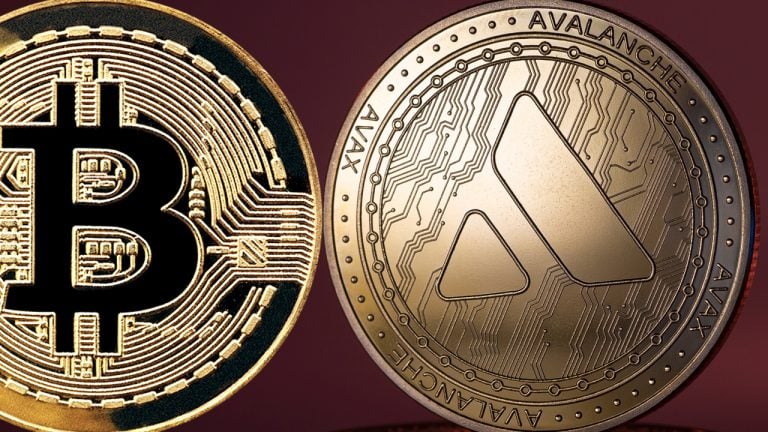
A long-dormant Ethereum (ETH) whale abruptly came to life over the weekend as the crypto markets continued to struggle. According to blockchain tracker Lookonchain, the Ethereum address moved 10,266 ETH worth about $16 million in two transactions early Sunday morning. The wallet obtained the ETH via mining in 2017 and hadn’t been active in more […]
The post Ancient Ethereum Whale Comes to Life, Transfers 10,266 ETH – Here’s Where the Crypto Is Going appeared first on The Daily Hodl.
 According to statistics, the number of bitcoin bridged to the Avalanche blockchain saw a significant inflow on March 2, as more than 2,000 bitcoin were bridged on that day. Data further shows that as of Friday, March 3, a total of 8,504 bitcoin worth $190.9 million was bridged over to the Avalanche network. Bitcoin Bridged […]
According to statistics, the number of bitcoin bridged to the Avalanche blockchain saw a significant inflow on March 2, as more than 2,000 bitcoin were bridged on that day. Data further shows that as of Friday, March 3, a total of 8,504 bitcoin worth $190.9 million was bridged over to the Avalanche network. Bitcoin Bridged […]
Popular crypto analyst Michaël van de Poppe thinks that one decentralized finance (DeFi) altcoin that’s been showing strength this year is likely due for a big bounce. Van de Poppe tells his 649,800 Twitter followers that GMX, the native asset of decentralized perpetual trading platform GMX, remains in an uptrend despite its recent corrective move […]
The post Trader Predicts Big Bounce for DeFi Altcoin, Updates Forecasts on Fantom and Polygon appeared first on The Daily Hodl.

Two crypto firms are scooping up large amounts of one fast-rising decentralized exchange (DEX) token, according to on-chain data from the Arbitrum blockchain. According to blockchain tracker LookOnChain, crypto finance service provider Amber and crypto institutional asset manager Arca are both in the midst of accumulating GMX, the popular DEX built on Arbitrum. Says LookOnChain, […]
The post Institutional Crypto Firms Accumulating Large Amounts of Ethereum-Based Decentralized Exchange Token: On-Chain Data appeared first on The Daily Hodl.

Popular crypto strategist Michaël van de Poppe is predicting bullish continuations for a handful of altcoins, including Avalanche (AVAX), Polygon (MATIC) and Chainlink (LINK). Van de Poppe tells his 649,000 Twitter followers that he believes the trend for smart contract platform Avalanche is still up, despite its recent pullback. “Difficult chart, it’s in between levels, […]
The post Extended Rallies for Avalanche, Polygon, Chainlink and Two Additional Assets Incoming, Predicts Top Crypto Analyst appeared first on The Daily Hodl.

This week’s bearish regulatory actions and rumors were not strong enough to suppress investors’ appetite for cryptocurrency.
The total crypto market capitalization rejected at $1.13 trillion on Feb. 16, but there was no change in the month-long ascending channel structure. More importantly, this level represents a 43% gain in 2023, which is far from the $3 trillion level achieved in November 2021. Still, the current recovery is notable.

As shown above, the ascending channel initiated in mid-January has left some room for a 10% correction down to $1 trillion without breaking the bullish formation.
Investors reacted positively to the 5.6% year-on-year U.S. Consumer Price Index inflation increase on Feb. 14 and the 3% retail sales monthly growth on Feb. 15. Bitcoin (BTC) had the biggest positive impact on the total crypto capitalization as its price gained 12.5% on the week.
One area of concern is a Feb. 16 story on Binance.US financial transactions to Merit Peak, a trading firm managed by CEO Changpeng Zhao. Interestingly, Reuters reported that a Binance.US spokesperson said Merit Peak was “neither trading nor providing any kind of services on the Binance.US platform.”
The 10.1% weekly increase in total market capitalization was held back by the modest 1.8% gains from BNB (BNB) and the XRP (XRP) 2.5% price increase. On the other hand, only three out of the top 80 cryptocurrencies finished the week with negative performances.

Decentralized storage solution Filecoin (FIL) gained 59% and Internet Computer (ICP) soared 52% as Bitcoin blockchain demand for nonfungible token (NFT) inscription vastly increased the block space.
GMX rallied 34% as the protocol received $5 million in transaction fees on a single day.
Lido DAO’s LDO gained 34% as stakers evaluated proposals to manage the 20,300 Ether (ETH) held by the corporate treasury.
Perpetual contracts, also known as inverse swaps, have an embedded rate that is usually charged every eight hours. Exchanges use this fee to avoid exchange risk imbalances.
A positive funding rate indicates that longs (buyers) demand more leverage. However, the opposite situation occurs when shorts (sellers) require additional leverage, causing the funding rate to turn negative.

The seven-day funding rate was close to zero for Bitcoin and Ether, meaning the data points to a balanced demand between leverage longs (buyers) and shorts (sellers).
Interestingly, BNB is no longer a top six cryptocurrency ranked by futures open interest, as investors’ demand for Polygon’s MATIC (MATIC) markets increased by 70% in February.
Traders can gauge the market’s overall sentiment by measuring whether more activity is going through call (buy) options or put (sell) options. Generally speaking, call options are used for bullish strategies, whereas put options are for bearish ones.
A 0.70 put-to-call ratio indicates that put options open interest lag the more bullish calls by 30% and is therefore bullish. In contrast, a 1.40 indicator favors put options by 40%, which can be deemed bearish.
Related: Bitcoin price derivatives look a bit overheated, but data suggests bears are outnumbered

Even though Bitcoin’s price failed to break the $25,000 resistance, the demand for bullish call options has exceeded the neutral-to-bearish puts since Feb. 14.
Presently, the put-to-call volume ratio nears 0.40 as the options market is more strongly populated by neutral-to-bullish strategies, favoring call (buy) options by 2x.
From a derivatives market perspective, there are no signs of demand from short sellers, while leverage indicators show bulls are not using excessive leverage. Ultimately, the odds favor those betting that the $1.13 trillion total market cap resistance will break, opening room for further gains.
This article does not contain investment advice or recommendations. Every investment and trading move involves risk, and readers should conduct their own research when making a decision.
The views, thoughts and opinions expressed here are the authors’ alone and do not necessarily reflect or represent the views and opinions of Cointelegraph.

BitMEX founder Arthur Hayes has reportedly seen the value of his GMX portfolio balloon by more than $8 million in a matter of months. The blockchain-tracking Twitter account Lookonchain reports that Hayes bought 200,580 GMX between March 3rd and September 7th of last year. He spent 3,386 Ethereum (ETH) worth $5.72 million at the time […]
The post BitMEX Founder Arthur Hayes Makes Massive $8,000,000 Profit Buying Up GMX: On-Chain Data appeared first on The Daily Hodl.

A crypto strategist says he’s keeping a close watch on three decentralized finance (DeFi) altcoins that he believes are showing strength amid the market consolidation. Pseudonymous analyst Altcoin Sherpa tells his 190,400 Twitter followers that decentralized exchanges DYDX (dYdX), GMX (GMX) and Injective (INJ) are “holding up very well” as the crypto rally takes a […]
The post Analyst Says Three DeFi Altcoins Are Flashing Strength Amid Crypto Pullback, Updates Outlook on Bitcoin appeared first on The Daily Hodl.
 A new decentralized exchange (dex) on Arbitrum, called Vest Exchange, was announced this past weekend, and the team that created the project said the platform aims to focus on democratizing perpetual futures. The team behind Vest further detailed that the new Arbitrum dex is backed by firms such as Jane Street, QCP Capital, and Big […]
A new decentralized exchange (dex) on Arbitrum, called Vest Exchange, was announced this past weekend, and the team that created the project said the platform aims to focus on democratizing perpetual futures. The team behind Vest further detailed that the new Arbitrum dex is backed by firms such as Jane Street, QCP Capital, and Big […]
Bitcoin and Ethereum are not part of the surprising list of five best and worst-performing cryptocurrencies for 2022.
Cointelegraph looks back on the best and worst-performing cryptocurrencies of 2022 among the top 100 assets by market capitalization. We used the highest and the lowest year-to-date (YTD) returns through the close of Dec. 25, 2022.
Overall, Cryptoindex.com 100 (CIX100), an index that tracks the 100 best-performing cryptocurrencies, fell nearly 68% YTD, suggesting most top coins underperformed in 2022.

Stablecoins are naturalomitted from the list below. Similarly, coins tracking the value of gold and similar mainstream assets have also been ignored.
Instead, the coins mentioned below include decentralized currencies, smart contract tokens, exchange tokens, and others.
GMX acts as a utility and a governance token within the GMX decentralized exchange (DEX) ecosystem and is the best-performing digital asset among the top 100 coins (excluding stablecoins).
GMX's price uptrend mostly picked its cues from the collapse of FTX, a centralized exchange, and its listing on popular trading platforms—including Binance and Huobi Global—across 2022. In addition, the token rallied impressively in late November after its platform briefly surpassed its top DEX rival, Uniwap in daily trading fees.

Trust Wallet Token (TWT) serves as a utility and a governance token within the Trust Wallet ecosystem. The token moved lower in tandem with the rest of the crypto market, mostly in 2022, but like GMX, its upside momentum increased amid the collapse of the FTX exchange in November.

As Cointelegraph reported, the FTX's collapse boosted mistrust for centralized exchanges, which may have prompted investors to move their funds to self-custody wallets like Trust Wallet. The speculation could have played a major role in boosting TWT's valuation.
Unus Sed Leo (LEO) is native to the iFinex ecosystem. The token suffered losses in 2022, but at -3.5%, they were little compared to most top coins, including Bitcoin (BTC) and Ether (ETH), which lost over 65% in the same period.

One of the reasons why LEO outperformed most top-ranking assets could be iFinex's pledge. Notably, the firm declared at the time of LEO's private sale in 2018 that it would employ 27% of its revenue to buy back the tokens until the entire supply of 985.24 million units was removed from circulation.
IFinex also said it would use the funds it lost during the August 2016 Bitfinex hack to purchase LEO tokens. That explains why LEO rallied by more than 100% at the start of the year, given the uptrend came after the U.S. Department of Justice recovered 94,000 BTC from Bitfinex hackers.
The rally took LEO's price to a YTD high of $8.15 in February. However, the token has dropped 55% since, though still remaining one of the best-performers in 2022.

OKB is the native token of the OKX exchange. It provides users discounts on trading fees, access to OKX's initial exchange offering (IEO) platform, and voting rights for tokens to be listed on the exchange.
OKB trended synchronously with the broader crypto market in 2022, including its 150% recovery after bottoming out at around $9.50 in June. The token's bullish retracement occurred despite the absence of a major market-moving event, suggesting it had been mostly speculative.

Overall, OKB's volatile recovery helped it limit its YTD losses compared to most top-ranking assets.
The Open Network is a layer-1 blockchain ecosystem developed by the Telegram founders Nikolai Durov and Pavel Durov. Its native token, TON, trended downward in line with other top crypto assets during most of 2022, but recovered impressively ahead of the year's close.

TON's recovery period coincided with back-to-back optimistic news. For instance, in October, Telegram announced that it would employ the Open Network to auction usernames. Similarly, the Open Network built a bot the next month that allows Telegrams users to trade cryptocurrencies in-app.
Nonetheless, TON failed to recoup all of its losses, still down 33.5% YTD at $2.36.
Related: Top-five most Googled cryptocurrencies worldwide in 2022
Terra (LUNA) was became a debacle for the cryptocurrency secti after its market valuation crashed by 99.99% in May. The unraveling started with the implosion of Terra's algorithmic stablecoin TerraUSD (UST), marking one of the biggest busts in the crypto industry's history.

Terra's implosion prompted its founder Do Kwon to suggest a fork to revive the project. Eventually, Terra underwent a chain split, with the old chain existing as Terra Classic (LUNC) and the new chain as Terra 2.0 (LUNA2).
LUNC jumped nearly 100% after its launch in late May 2022 while LUNA2 dropped around 40% in the same period.
FTX Token (FTT) served as a native token to FTX, which collapsed after facing a liquidity crisis in November.

The token continues to trade across several exchanges but accompanies poor liquidity and volume. It is technically "dead" given the defunct status of FTX.
Solana (SOL), a layer-1 blockchain protocol, crashed 93.35% YTD due to a sequence of bad news all across 2022. That includes six network outages in the year, a $200 million hack on a Solana-based wallet, and Solana's association with FTX.

More bad coverage appeared in the form of accusations that Solana is not as decentralized as it claims to be, resulting in SOL being one of the worst-performers of 2022.
Axie Infinity Shard, or AXS, serves primarily as the governance token for Axie Infinity, a play-to-earn (P2E) gaming ecosystem. It also acts as a legal tender in the Axie Infinity marketplace, where in-game nonfungible tokens (NFT) can be purchased.
The AXS market has consistently trended lower in 2022 due to underwhelming players turnout (which lowers demand for tokens), a $650 hack concerning Axie Infinity's blockchain Ronin in late March, and fears surrounding the unlocking of 8% of supply in October.

AXS is down approximately 93% YTD, becoming one of the worst-performing assets in the current bear market.
Like Axie Infinity, the Sandbox is a virtual platform where users can create, own, and monetize their gaming skills using NFTs and SAND, the platform’s utility token. But despite initial success, the platform now has less than 500 unique users, according to data from Dappradar.
The lower turnout has affected SAND's demand across spot exchanges, which, in turn has pushed its price down 93.50% YTD, as shown below. Other factors behind the declining interest include a general lack of demand for riskier assets in a higher interest rate environment.

Other tokens that fell more than 90% YTD are Fantom (FTM), Avalanche (AVAX), Algorand (ALGO), Decentraland (MANA), BitTorrent (BTT), etc.
This article does not contain investment advice or recommendations. Every investment and trading move involves risk, and readers should conduct their own research when making a decision.